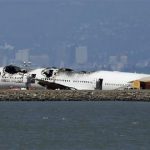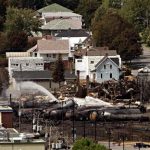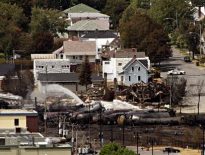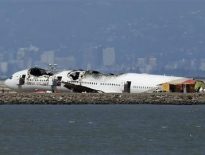SOUTH SAN FRANCISCO, Calif. (AP) — Asiana Airlines Flight 214 was 500 feet up and about a half-minute from San Francisco International Airport when its speed dropped below the threshold for a safe landing speed. It continued slowing until just about 8 seconds before touch down when pilots recognized the need for more speed and throttled up.
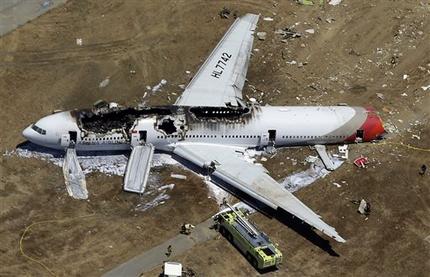
But it already was too late. By the time the engines started adding speed, the hulking Boeing 777 was barely above San Francisco Bay and the plane clipped the seawall at the end of the runway, slammed down and spun, then caught fire. Incredibly, only two of the 307 people on board died, and most of the survivors suffered little or no injuries.
The head of the National Transportation Safety Board on Monday revealed additional details about the final seconds before Saturday’s crash but what remained unknown was why the pilots didn’t react sooner.
Some of those answers are expected to come Tuesday, after details emerge from U.S. and Korean joint interviews with the pilots that began Monday.
Choi Jeong-ho, a senior official for South Korea’s Ministry of Land, Infrastructure and Transport, told reporters in a briefing Tuesday in South Korea that investigators from both countries quizzed two of the four Asiana pilots, Lee Gang-guk and Lee Jeong-min, on Monday, and they planned to quiz the two other pilots and air controllers Tuesday.
Choi said recorded conversation between the pilots and air controllers at the San Francisco airport would be investigated, too.
“I think this accident is going to go down as a textbook case study on what they call Cockpit Resource Managements, which is a fancy way of saying how the pilots talk to each other and identify solutions,” said former NTSB managing director Peter Goelz.
He said it’s very helpful, and not all that common after a major crash, to have pilots to interview.
“It’s always good to have survivors,” he said.
As for the interviews, “The reality is this is not going to be an interrogation,” he said. “The NTSB will ask them to tell us in your own words what was going on. The investigators will have some advantage, they’ll have some information from voice recorder. But it’s not a cross examination, it’s an effort to understand what the pilot remembers and what he remembers saying and doing.”
He said there is a possibility a license could be revoked, or fines or penalties issued.
“The FAA will take a look at this going down the road and see if there were any egregious violations,” he said.
The challenge for authorities this week is to discover what decisions were made in the cockpit of the giant jet, where an experienced pilot was learning his way around a new aircraft and fellow pilots were supposed to be monitoring his actions. Questions include whether all four pilots were in the cockpit, as expected, or just the trainee and his trainer, both experienced pilots.
In addition, authorities were reviewing the initial rescue efforts after fire officials acknowledged that one of their trucks may have run over one of the two Chinese teenagers killed in the crash. The students, Wang Linjia and Ye Mengyuan, were part of a larger group headed for a Christian summer camp with dozens of classmates.
National Transportation Safety Board Chairman Deborah Hersman said investigators reviewed flight data and watched airport surveillance video to determine whether an emergency vehicle ran over one of students. But they have not reached any firm conclusions. A county coroner said he would need at least two weeks to rule in the matter.
The teens had been seated in the rear of the aircraft, where many of the most seriously injured passengers were seated, Hersman said. Their bodies were found on the tarmac.
The investigators found traces of fire on the left side of the exterior parts of the plane’s right engine, according to a statement from South Korea’s Ministry of Land, Infrastructure and Transport. They also detected a skid mark at the runway, it said.
The NTSB also said part of the jet’s tail section was found in San Francisco Bay, and debris from the seawall several hundred feet down the runway, indicating the plane hit the seawall on its approach.
Two other South Korean investigators – one from the government and one from Asiana – left for Washington to take part in an analysis of the plane’s black box, and they are to arrive in Washington 11:20 a.m. local time Tuesday, the statement said.
The airline acknowledged Monday in Seoul that the pilot at the controls had little experience flying that type of plane and was landing one for the first time at that airport.
Asiana spokeswoman Lee Hyomin said pilot Lee Gang-guk had logged nearly 10,000 hours operating other planes but had only 43 hours in the 777, a plane she said he still was getting used to flying.
It was unclear whether the other two pilots were in the cockpit, which seats four. But that would be standard procedure at the end of a long international flight.
More than 180 people aboard the plane went to hospitals with injuries. But remarkably, more than a third didn’t even require hospitalization.
The passengers included 141 Chinese, 77 South Koreans, 64 Americans, three Canadians, three Indians, one Japanese, one Vietnamese and one person from France.
South Korea officials said 39 people remained hospitalized in seven different hospitals in San Francisco. South Korean officials and 62 workers from Asiana and 30 from United Airlines are assisting the injured passengers and their family members.
The flight originated in Shanghai, China, and stopped over in Seoul, South Korea, before making the nearly 11-hour trip to San Francisco.


